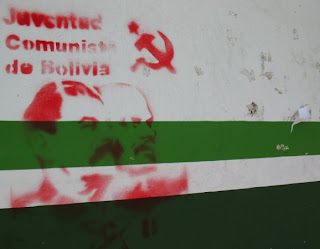 The bus's descent from the windswept Altiplano, down and around the treacherous twists of the mountain highway and into the Cochabamba Valley, was a long one. Yet, the sharp ridges and vertigo prevented any panoramic views of the city itself, and so it was only a few days ago, when I hopped in the cable car to the top of Cerro San Pedro, that I finally was able to drink in this sprawling city-home in its entirety.
The bus's descent from the windswept Altiplano, down and around the treacherous twists of the mountain highway and into the Cochabamba Valley, was a long one. Yet, the sharp ridges and vertigo prevented any panoramic views of the city itself, and so it was only a few days ago, when I hopped in the cable car to the top of Cerro San Pedro, that I finally was able to drink in this sprawling city-home in its entirety.Taller by centimeters than its world-famous counterpart in Rio, Cochabamba's Cristo de la Concordia gazes down from San Pedro over a flock of more than 600,000 souls (1 million+ if he factors in the metropolitan area). From this perch, it's possible to follow the flow of the city from its nexus in the center of the valley, south past the Laguna Alalay and into the hills, north and west into the high mountains of Parque Nacional Tunari, and east towards the horizon.

Cochabamba is Bolivia's third-largest city but home to its most favorable climate. Wedged between the high chill of La Paz and the sultry jungle of Santa Cruz, the city's temperatures are refreshingly mild, despite its elevation of 8,400 feet. Rain falls daily in the midst of summer, but a powerful sun dominates days the rest of the year. Known as the "City of Eternal Spring," its streets are lined with flowering trees, its parks verdant.

Its recent history, however, is not as tranquil as this atmosphere would suggest. Just nine years ago, Cochabamba was gripped by unrest during what is now known as the Water War. It began when the World Bank forced the city to sell its water utility to a multinational consortium inculding U.S. corporation Bechtel. The consortium's solution to the problems with Cochabamba's water system was to immediately hike rates to over $20 a month--ridiculous, considering most people here make only about $100 monthly.
Needless to say, city residents were upset, and the first four months of 2000 saw repeated mass demonstrations, road blockades, and violent clashes between police, protesters, and the military. Eventually, the consortium was forced out, leaving Cochabambinos with a sense of victory but a still-crippled water distribution network. Similar scenes played out over the next several years, this time over the privatization of Bolivia's natural gas reserves. Different players, same story.

Almost as tumultuous as this history is La Cancha, Cochabamba's sprawling market that, according to some, is the largest in South America. I could probably spend every day of my time here exploring La Cancha and still come away with an incomplete picture. I won't even bother devising a list of exotic and frightening things for sale--name anything and it's there. Not only that, but there are probably twenty stalls selling it.
I've only been to market once, as the effort required to get there, around, and back from my comfortable residential neighborhood near Universidad San Simón is demanding. And honestly, it's so easy to find everything I need within this little square mile, including the offices of my volunteer organization, that I seldom venture out. Even Cristo lives here. Most of the tiny scale-model city I spied from atop his hill--the posh neighborhoods of the north, imporverished adobe barrios of the south, and everything in between--remains unexplored...for now.
For this moment in time, this is home.

2 comments:
I miss that feeling of settling in someplace new. And thanks for explaining about the water wars--not enough people know about attempts to privatize water.
Just today I was remarking on how nice it was that I was beginning to see the city through familiar eyes. It makes everything seem friendlier when you know what to expect.
When and where was your last new home, Beth?
Post a Comment